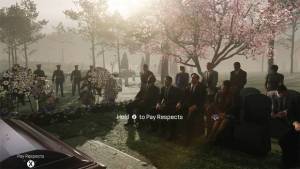by Mindy
As I alluded to in my last post, I am totally fascinated by the interactivity-quotient (IQ?) of story-based games: what makes choices meaningful, and what makes them feel pointless?
Shallow, half-hearted player agency in games can be ineffective to the point of self-parody: witness the famed “press X to pay respects” bit in Call of Duty: Advanced Warfare (see this gallery for a host of examples of this phenomenon). Such moments (when not intentionally played for laughs) pour ice water over a player’s suspension of disbelief, and remind them: “This is just a game.”
At times, I worry that RPG gaming has tilted a bit too far into giving players the feeling of agency at the cost of other qualities. It is easy to come to the mistaken belief that player agency and player investment go hand in hand. Sandbox games, for example, can feel anarchic and pointless at times – at least in me, they tend to inspire the ennui of “I can do anything!…. So what?” It’s worth remembering that impactful player choices come at a cost – they spread the resources of the writers and devs necessarily thinner. And we sometimes forget in modern gaming that branching narratives are neither necessary nor sufficient to create a game that is deeply compelling and engaging on a character and story level. Hundreds of games (Portal 2 and Final Fantasy 7 spring to mind as examples) tell stellar stories that are what they are: static.
One brilliant twist on player choice that I’m particularly excited about right now and would like to highlight is found in investigative-style indie games like Gone Home, The Sailor’s Dream, or Her Story. These games offer cunningly constructed player choice that leaves the outcome of the game utterly unaffected. Instead, player choice is essentially limited to choosing the order of information uncovered, and the extent of it.
Her Story is particularly genius in how different a playthrough can be from player to player, notwithstanding that the same information is available to the player at all times, and the ending will never change. Upon opening Her Story, the player is confronted with a 90’s-style computer desktop. She shortly discovers that a police database is open, and that it contains solely short clips of a variety of police interviews with one woman. The database is searchable, but can only pull up the first five videos which contain the search term. The first term in the box is “Murder.” The player must pick up on hints and visual cues in the videos and at times engage in a bit of creative guesswork and free association in order to successfully brainstorm search terms. The player experiences the plot of the game as a sort of detective thriller, ramping up as more clues are revealed. Which secrets are revealed in which order has no effect on the game’s conclusion, but utterly defines the player’s experience of the story. The path the player takes through the game is defined by her own mind: What jumps out at her? What is she curious about? What shots in the dark does she decide to try in the search bar?
I am so excited about the ways in which modern games like Her Story are pushing at the boundaries of the form, and finding new ways to give players unique and personal gameplay experiences. In my own self- interest, I’m both hopeful that cutting edge games will keep playing with creative definitions of narrative choice, and that they won’t forget that a good yarn is a good yarn, even if the player doesn’t get to decide what happens in the end.



I should take this opportunity to plug my friend Caelyn’s interactive fiction games! I especially recommend Bloom because it’s a very powerful story. As far as I can tell, the player’s choices affect the tone of responses and the timing of certain elements in the story, but not where it goes. But because it’s the story of an emotional journey, among other things, timing can be a big factor in the experience. I’m sure she would be thrilled if any of the foxes played her games and mentioned them on the show — and she’s local, so I could introduce you sometime if you want. http://inurashii.xyz/bloom/
LikeLike